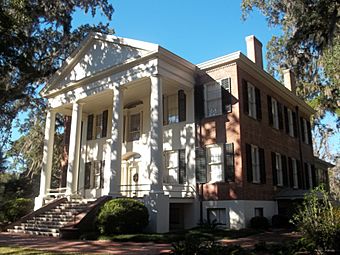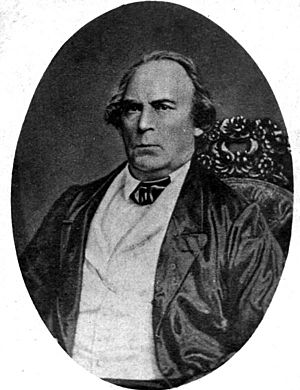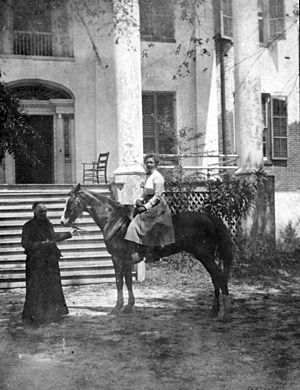The Grove Plantation facts for kids
|
The Grove Plantation
|
|

The Grove in 2019
|
|
| Location | Leon County, Florida |
|---|---|
| Nearest city | Tallahassee |
| Architectural style | Greek Revival |
| NRHP reference No. | 72000335 (original) 100003925 (increase) |
Quick facts for kids Significant dates |
|
| Added to NRHP | June 13, 1972 |
| Boundary increase | April 25, 2019 |
The Grove, also known as the Call/Collins House at The Grove, is an old plantation house in Tallahassee, Leon County, Florida. It was built around 1840 by Richard Keith Call, who was the governor of Florida when it was still a territory.
In 1851, Call gave the property to his daughter, Ellen Call Long. She owned it until 1903. Later, her granddaughter, Reinette Long Hunt, took over. Reinette even opened The Grove Hotel there and rented out small cottages.
After a short time with other owners, LeRoy Collins and his wife, Mary Call Darby Collins, bought The Grove. Mary was a great-granddaughter of Richard Keith Call. LeRoy Collins later became the governor of Florida. While the new Florida Governor's Mansion was being built (from 1955 to 1957), The Grove was used as the unofficial home for the governor.
The Collins family owned The Grove until 1985. Then, the state of Florida bought it to turn it into a historic house museum. The Collins family was allowed to live there for the rest of their lives. After Mrs. Collins passed away in 2009, the property officially became a state museum. There's also a small family cemetery on the property where several generations of the Call and Collins families are buried. Today, The Grove is a museum you can visit.
Contents
The Call Family at The Grove
Richard Keith Call: Florida's Territorial Governor
The land where The Grove stands was bought by Richard Keith Call in 1825. He came to Tallahassee after serving in the U.S. House of Representatives. Call was a close friend of future president Andrew Jackson. He used his connections to get a job with the federal land office in Tallahassee. The first house on the property was built around 1825. It was a simple building with several rooms. People say that Call's wife, Mary Kirkman Call, named the property "Hickory Grove."
In 1836, President Andrew Jackson made Richard Keith Call the Territorial Governor of Florida. A big problem at that time was the Second Seminole War. Call was very involved in this war. Before becoming governor, he led the Florida Militia. He fought in the Battle of Withlacoochee in 1835.
The exact date The Grove was built isn't known. But in 1838, someone wrote that Governor Call was building "a very fine brick house." The Grove was finished by the end of 1839.
Because it was built during the Second Seminole War, safety was important. The house has thick brick walls and columns, making it look like a fortress. The bricks were probably made right there. They also built a cistern (a tank for collecting water) for clean water. The building materials like wood floors, marble fireplaces, and window sills likely came by the new Tallahassee Railroad, which was finished around that time.
Enslaved craftspeople built The Grove. Many of them were likely hired from other slave owners. Their skill is clear because the building is still standing strong after over 175 years. While Call owned many enslaved people, The Grove was not mainly a farming plantation. Call focused on buying and selling land, his law practice, the railroad, and politics.
In 1845, Call stopped being active in politics after he lost a governor's race. He then spent more time at his other plantation, Orchard Pond. In 1851, he gave The Grove and seven enslaved people to his daughter, Ellen. He often visited The Grove. In 1861, when Florida decided to leave the United States, Call, who wanted Florida to stay in the Union, stayed at The Grove. He famously told a group of people who supported leaving the Union, "You have opened the gates of hell." He died in 1862.
Ellen Call Long: A Woman of Many Talents
After Ellen Call Long got The Grove, it stayed a popular place for important people in Tallahassee. Her husband, Medicus A. Long, was a successful lawyer and state senator. Ellen, like her father, wanted Florida to stay in the Union, which caused problems with her husband, who wanted to leave. They separated in the late 1850s. They had eight children, but only two lived to be adults.
During the Civil War, even though she didn't want Florida to leave the Union, Ellen helped the Confederacy. Her son, Richard Call Long, Sr., served in the military. She opened The Grove to Confederate officers and wounded soldiers. She also joined a group of women who made clothes for Confederate soldiers. The Grove hosted social events during the war, including a May Day party in 1865, just after news of the war ending reached the city.
After the war, Ellen Call Long traveled and promoted Florida. To support her family, she started raising silkworms at The Grove. She became an expert in silk farming in Florida. She even helped make a large American flag from silk grown at The Grove, which was shown at the governor's inauguration in 1885. Ellen also became interested in forestry and was one of the first people in Florida to suggest controlled burning to manage forests.
By the late 1800s, Ellen faced financial difficulties. She started selling parts of the land around The Grove. Eventually, she lost The Grove in 1903 due to money problems. Her granddaughter, Reinette Long Hunt, ended up owning it. Ellen died in 1905 and is buried in the family cemetery.
LeRoy and Mary Call Darby Collins: Governors and Restorers
When LeRoy Collins and his wife, Mary Call Darby Collins, bought The Grove in 1941, it was in very bad shape. Mary was a great-granddaughter of Richard Keith Call. Her family connection helped them buy the property for a good price. LeRoy Collins was a young lawyer and politician at the time. Their work on the house stopped when Collins joined the Navy during World War II. Even though the Collins family left, The Grove was used by servicemen visiting Tallahassee during the war.
After World War II, Collins went back to his law practice and his work in the state legislature. The Collins family made changes to their home in the late 1940s. They added a sunroom, which they called the Florida Room. They also used old bricks from Monroe Street to create patios outside the house.
In 1954, Collins ran for governor and won. When he became governor in 1955, the state decided to build a new Governor's Mansion. So, The Grove became the unofficial Governor's Mansion until the new one was finished in 1957. Mary Call Darby Collins helped choose the furniture for the new mansion. She also hired an expert to help furnish The Grove with old pieces that fit the house's history.
Collins was a very popular governor. He was re-elected in 1956, becoming the first sitting governor in Florida to win re-election. He became involved in the debate over integration, which was about ending racial segregation. He disagreed with the state legislature's plan to oppose the Supreme Court's ruling on Brown v. Board of Education. Collins's moderate stance on civil rights caught the attention of national leaders. He later worked for President Lyndon B. Johnson and played a role in the Civil Rights marches in Selma, Alabama, in 1965. His involvement in Selma later affected his political career.
After his political career ended, LeRoy Collins and his family returned to The Grove. They didn't want to sell the house outside the family. In the 1970s, the state of Florida became interested in buying it.
The Grove Hotel Era
Reinette Long Hunt owned The Grove from 1903 until she died in 1940. She faced challenges as a single woman managing the property. Reinette turned her home into an art studio, where she sold art and taught classes. She also rented out Orchard Pond plantation, which she later sold.
Reinette became friends with many wealthy people who moved to Tallahassee. This friendship led her to open The Grove to the new Tallahassee Country Club. The Grove served as its first clubhouse, and the nearby grounds even had a few golf holes.
In the 1920s, Reinette started The Grove Hotel. She advertised it as "The Home of the Tallahassee Girl." The hotel's location near the Governor's Mansion made it perfect for visiting politicians and lawyers. Richard Ervin, who later became a chief justice of the Florida Supreme Court, rented the entire second floor in the 1920s. In 1924, the Tallahassee Centennial celebrations were held at The Grove. Reinette also built three small cottages on the property to rent out.
On New Year's Day, 1934, The Grove caught fire. The fire mainly damaged the attic and roof. Reinette's brother, Richard Call Long Jr., died from injuries he got while fighting the fire. Before she died, Reinette gave the family cemetery to a local Masonic Lodge to protect it. Despite her efforts, Reinette was having financial problems and was about to sell off more of the property when she died in 1940. The property then went to her distant cousins, John W. Ford and Josephine Ford Agler, before being sold to LeRoy and Mary Call Darby Collins.
The Grove as a State Museum
In 1985, the State of Florida officially bought The Grove from the Collins family. The plan was to open it as a historic house museum. LeRoy and Mary Call Darby Collins were allowed to live there for the rest of their lives. After Mrs. Collins died in 2009, the state began a full restoration of the property.
The Florida Department of State worked to prepare the building for public use. The building was extensively repaired. This included fixing the structure, windows, and walls. They also restored the old cistern, updated the plumbing, and added safety features. To make the building accessible for everyone, they built a ramp and an elevator.
The restoration followed Leadership in Energy and Environmental Design (LEED) guidelines, which focus on environmentally friendly building practices. A carport built by the Collins family was turned into public bathrooms. A pump was installed in the cistern to collect rainwater for watering the lawn, which helps save city water. They also tried to reuse as much of the original building materials as possible. Items that couldn't be reused, like old sinks and toilets, were donated to Habitat for Humanity.
The Grove's Architecture
The Grove is a great example of Greek Revival architecture, which was popular before the Civil War. Some key features of the house include a tall front porch with four large columns. It also has a decorative trim along the roofline, fancy doors on both the first and second floors, and a balanced layout inside. These are all typical of the Greek Revival style.
The main entrance has double wooden doors with decorative side windows and a fan-shaped window above. The second-story entrance looks similar, but with a simpler fanlight and a small balcony. Legend says a ship carrying materials for a larger second-story balcony was lost at sea, so it was never finished.
The outside and inside walls, including the columns, are made entirely of brick. Most of the exterior brick is visible, except for the front porch, which is covered with stucco. Most of the windows are original. The house has a low, sloped roof with slate shingles and four brick chimneys.
The inside of The Grove has a Georgian design. This means there's a central hallway on both floors with two rooms of the same size on each side. A special feature inside is a spiral staircase that goes from the first to the second floor. It looks similar to the staircase in The Hermitage in Nashville, Tennessee. Other cool details include decorative trim around the windows and marble fireplaces in the first-floor living and dining rooms. All the rooms in the house have fireplaces.
Gallery














